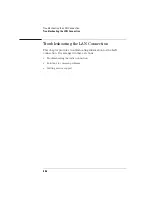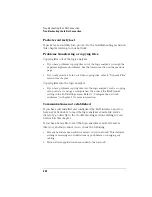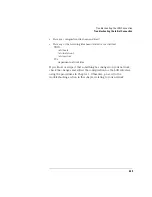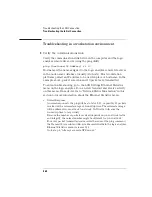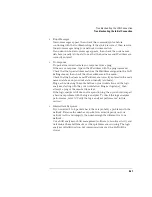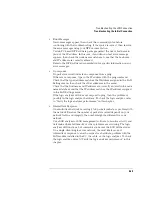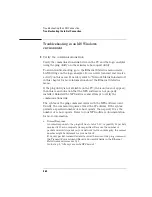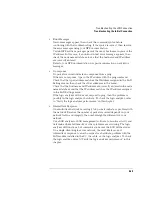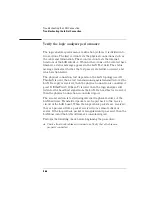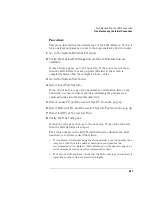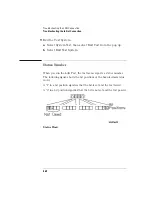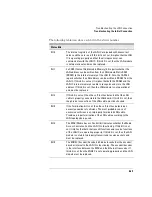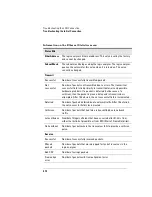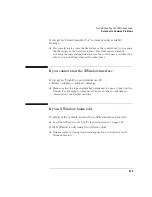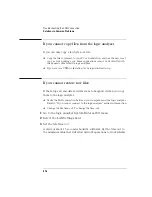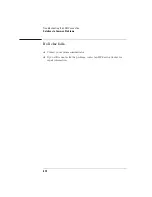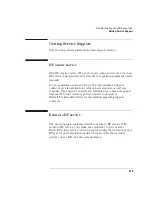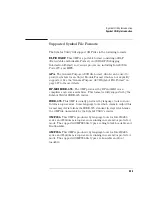
570
Troubleshooting the LAN Connection
Troubleshooting the Initial Connection
Status Bits (continued)
Status Bits
Bit 6
The TRANS (Transceiver, such as Ethernet transceiver) bit
indicates whether the circuitry between the LAN IC and the LAN
cable is functioning. If this bit is not set, then the path between the
LAN cable and the LAN IC is operating properly. If this bit is set,
then either the CPU board or the I/O board must be replaced.
Bit 7
Timeout bit. If the Timeout bit is set, then bits 4, 5, or 6 will also be
set. Refer to the appropriate bit for a suggested course of action.
Bit 8
The Tx bit indicates whether the transmission portion of the MAC,
ENDEC, or TRANS test failed. Therefore, the Tx bit is used in
conjunction with bits 4, 5, and 6. Refer to the appropriate bit for the
suggested course of action.
Bit 9
The Rx bit indicates whether the receive portion of the MAC,
ENDEC, or TRANS test failed. The Rx bit is used in conjunction with
bits 4, 5, and 6. Refer to the appropriate bit for the suggested
course of action.
Bit 10
The Parameters bit indicates the integrity of the LAN module self-
test parameters. If this bit is not set, then the parameters sent to
the self-test routine are correct. If this bit is set, then contact your
nearest HP Sales and Service Office.
Bit 11
The EPROM that is used to hold the Ethernet address, IP address,
and gateway address has been corrupted. If this bit is set, the LAN
board must be replaced.
Bits 12-15
Not Used
Summary of Contents for 1670E Series
Page 6: ...6 In This Book...
Page 26: ...26 Contents...
Page 27: ...27 Section 1 Logic Analyzer...
Page 28: ...28...
Page 29: ...29 1 Logic Analyzer Overview...
Page 39: ...39 2 Connecting Peripherals...
Page 49: ...49 3 Using the Logic Analyzer...
Page 72: ...72 Using the Logic Analyzer The Inverse Assembler...
Page 73: ...73 4 Using the Trigger Menu...
Page 101: ...101 5 Using the Oscilloscope...
Page 151: ...151 6 Using the Pattern Generator...
Page 199: ...199 7 Triggering Examples...
Page 237: ...237 8 File Management...
Page 249: ...249 9 Logic Analyzer Reference...
Page 360: ...360 Logic Analyzer Reference The Compare Menu...
Page 361: ...361 10 System Performance Analysis SPA Software...
Page 397: ...397 11 Logic Analyzer Concepts...
Page 430: ...430 Logic Analyzer Concepts The Analyzer Hardware Oscilloscope board theory Oscilloscope board...
Page 439: ...439 12 Troubleshooting the Logic Analyzer...
Page 455: ...455 13 Specifications...
Page 471: ...471 14 Operator s Service...
Page 479: ...479 Operator s Service Troubleshooting Troubleshooting Flowchart 2...
Page 491: ...491 Section 2 LAN...
Page 492: ...492...
Page 493: ...493 15 Introducing the LAN Interface...
Page 497: ...497 16 Connecting and Configuring the LAN...
Page 506: ...506 Connecting and Configuring the LAN Connecting and Configuring the LAN...
Page 507: ...507 17 Accessing the Logic Analyzer File System Using the LAN...
Page 515: ...515 18 Using the LAN s X Window Interface...
Page 527: ...527 19 Retrieving and Restoring Data Using the LAN...
Page 539: ...539 20 Programming the Logic Analyzer Using the LAN...
Page 546: ...546 Programming the Logic Analyzer Using the LAN Programming the Logic Analyzer Using the LAN...
Page 547: ...547 21 LAN Concepts...
Page 555: ...555 22 Troubleshooting the LAN Connection...
Page 580: ...580 Troubleshooting the LAN Connection Getting Service Support...
Page 581: ...581 Section 3 Symbol Utility...
Page 582: ...582...
Page 583: ...583 23 Symbol Utility Introduction...
Page 588: ...588 Symbol Utility Introduction Symbol Utility Introduction...
Page 589: ...589 24 Getting Started with the Symbol Utility...
Page 597: ...597 25 Using the Symbol Utility...
Page 609: ...609 26 Symbol Utility Features and Functions...

